Sales On All My Digital Learning Resources
For the magical weekend coming up (Black Friday through Cyber Monday 🙂 ), I’m holding a storewide 20% off sale. In addition, I’m offering my two biggest items for 60% off their normal price. (Also, see below for information about a free printable math game.)
You can read more about the details of the sales and products, or check out my store here: https://www.teacherspayteachers.com/Store/Sandra-Balisky.
60% off my 2 main products
I’m offering my main two products for 60% off this coming weekend because I’d love to get them into your hands and give you a chance to explore some solid, fundamental math concepts with your kids in an innovative, inspiring way. I believe that students from Pre-K through Algebra 1 will benefit from these units and will enjoy learning math with these engaging activities that will supplement any math curriculum.
(1) Teaching Math Using Ten Frames
My full ebook on teaching/learning math with ten frames normally sells for $7.50, but I will set it at $3.75 with an additional storewide 20% discount from Nov. 24 – 27, 2017. This 28 page guide includes instructions for discovery-based learning activities, examples, and interactive journal pages to help your children develop number sense, mathematical fluency, and mental math skills. This would be most applicable for students in Pre-K through 3rd grade. You can read more about it below or see the full product with previews here. You can receive a free chapter from this book if you subscribe to my newsletter (you’ll find an opt-in form for this free download at the top of this site or on the sidebar.)
(2) Developing Algebraic Reasoning
My ebook on using balance scales to develop Algebraic reasoning normally sells for $5.50 but I will set it at $2.50 with an additional storewide 20% discount from Nov. 24 – 27, 2017. Based on my experience teaching high school Algebra and homeschooling my own children, I have created this activity-based lesson pack to help you take your students through the amazing journey of thinking abstractly, reasoning mathematically, and communicating effectively while exploring hands-on activities (with candy!). I have scaffolded the lessons so that students of any age can complete and understand the lessons; younger students can explore ideas tangibly and intuitively while older students will see connections to other math concepts and will learn to confidently manipulate equations to solve for a single variable based on a strong visual and concrete understanding. You can read more details below, or see the full product with previews here.
Free Printable
Before I get into the details of this unit, I want to offer a free printable ten frame math game that you can print and use anytime (or all the times! 😉 ) in math centers or at home.

Based on some games and activities I made up using ten frames with my own kids, I designed this mini activity pack as a free download to help encourage students to enjoy playing math games. These simple activities help to develop a strong foundation in number sense. You can download it for free at my TPT store (no email required) by clicking on the link above.
Developing Mathematical Reasoning Using Ten Frames
My most comprehensive product so far (although by this time next year I plan to have much larger products 😉 ) is a 28 page parent teaching guide with interactive activities for kids based on ten frames that takes students from beginning math (counting and understanding numbers) through adding and subtracting double digit numbers. You can see the product and full detail here.
Overview of the Ten-Frame Unit:
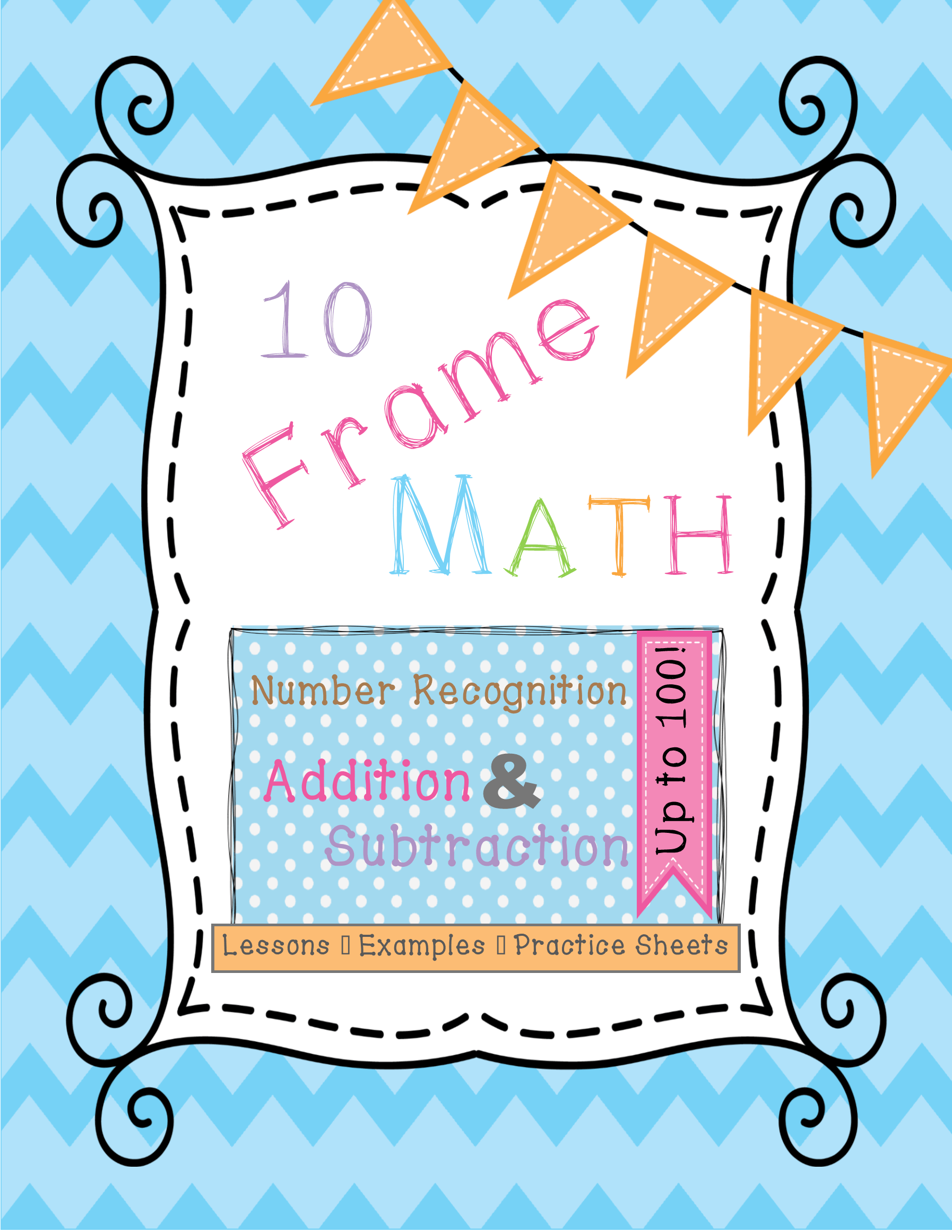 This unit is made of 4 lessons. Each lesson includes full explanations for teachers and activities for students including printable journal pages for practice and learning games; the entire unit is designed to help foster number sense, mathematical communication, and discovery-based learning.
This unit is made of 4 lessons. Each lesson includes full explanations for teachers and activities for students including printable journal pages for practice and learning games; the entire unit is designed to help foster number sense, mathematical communication, and discovery-based learning.
Lesson 1 begins with number recognition from 1 – 10 focusing on building numbers in groups of 5. It then moves up to recognizing and building numbers up through 20.
Lesson 2 focuses on addition up through 20 with an emphasis on combinations of numbers that add to 10 and their associated fact families.
Lesson 3 goes on to more complex addition (up through 100) and teaches students to break numbers up into groups of 10’s and 5’s and re-arrange as needed to come up with the answer. The strategies explained here help to build a strong conceptual understanding of addition rather than emphasizing an algorithm (set of steps to follow).
Lesson 4 teaches students to subtract numbers (up through 100) by visualizing them in groups of 10’s (with sub-groups of 5’s).
Brief introduction to ten frames:
 Since our number system is built around groups of 10, it is essential for kids to learn from a young age how to identify and manipulate numbers within our base 10 system.
Since our number system is built around groups of 10, it is essential for kids to learn from a young age how to identify and manipulate numbers within our base 10 system.
To provide a strong foundation for fluency in the language of numbers, students should be introduced first to visual representations of numbers. If they can recognize amounts at a glance based on groupings of 5’s and 10’s, this will pave a strong foundation for them to become comfortable and confident working with numbers. Once they can comfortably understand and explain how all single digit numbers relate to 10, it’s a simple matter to start adding or subtracting double digit numbers by re-arranging numbers into 10’s, 5’s, and 1’s.
Ten frame activities are a great way to introduce these topics. The activities in this lesson pack describe fun (and unconventional!) ways to use ten frames. You can purchase ten frames sold as sets with counting items, or you can simply draw ten frames on paper and use items you have around the house as the objects for counting (rocks, cheerios, marbles, legos, macaroni pieces, beads, etc.). I’ve also used an empty egg carton as a ten frame container after cutting it down to size.
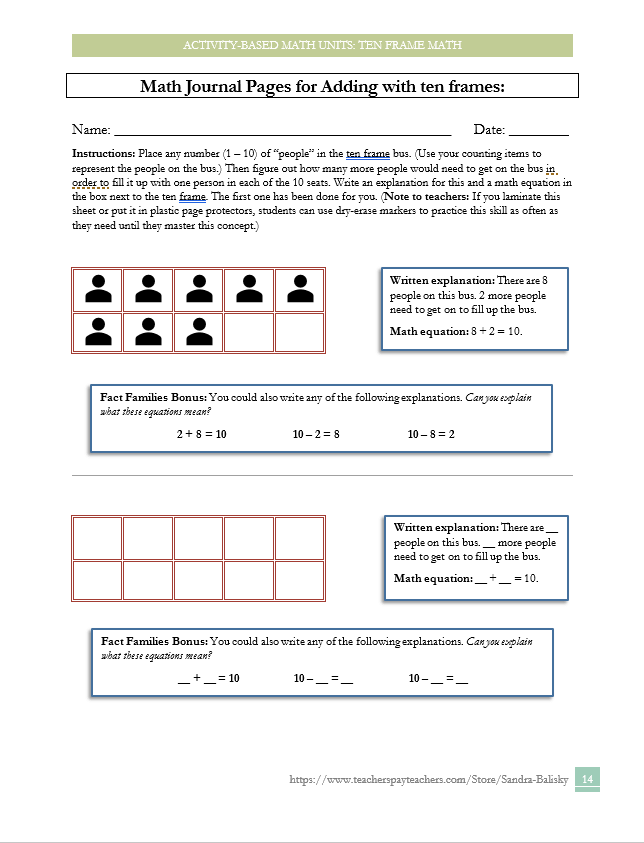 For those of you who are familiar with base-10 blocks, some of these activities may look familiar. Although the same basic idea applies to base-10 blocks, the added value of breaking groups of 10 into sub-groups of 5’s makes this a viable strategy for mental math, even with large numbers. Students can instantly imagine “glance-able” amounts of objects, break apart and re-arrange numbers, and recombine the “leftovers” to figure out the final answer. And again, since amounts of objects up to 5 can be known at a glance, without counting, and since all numbers can be broken up into 10’s and 1’s (bigger numbers into 100’s and 10’s and 1’s, etc.), students can take this one step further (instantly, in their head) to see numbers as combinations of 5’s within groups of 10’s and solve larger addition or subtraction problems.
For those of you who are familiar with base-10 blocks, some of these activities may look familiar. Although the same basic idea applies to base-10 blocks, the added value of breaking groups of 10 into sub-groups of 5’s makes this a viable strategy for mental math, even with large numbers. Students can instantly imagine “glance-able” amounts of objects, break apart and re-arrange numbers, and recombine the “leftovers” to figure out the final answer. And again, since amounts of objects up to 5 can be known at a glance, without counting, and since all numbers can be broken up into 10’s and 1’s (bigger numbers into 100’s and 10’s and 1’s, etc.), students can take this one step further (instantly, in their head) to see numbers as combinations of 5’s within groups of 10’s and solve larger addition or subtraction problems.
 Although the process explained in the following lessons may look elaborate and lengthy, once students have solidly grasped these fundamental concepts they will be able to do higher level math problems nearly instantly in their heads. Learning math in this way will help them become confident and happy learners. The steps explained in this lesson pack are designed to lead children at their own pace to a solid understanding of the number system; each step builds on previous concepts so that children can extend ideas they’ve mastered to new situations without ever being forced into frightening new territory where they find themselves ill-equipped to answer questions.
Although the process explained in the following lessons may look elaborate and lengthy, once students have solidly grasped these fundamental concepts they will be able to do higher level math problems nearly instantly in their heads. Learning math in this way will help them become confident and happy learners. The steps explained in this lesson pack are designed to lead children at their own pace to a solid understanding of the number system; each step builds on previous concepts so that children can extend ideas they’ve mastered to new situations without ever being forced into frightening new territory where they find themselves ill-equipped to answer questions.
Note: If you learned certain patterns of steps (an algorithm) for adding or subtracting large numbers and if you understood why those steps worked and you got pretty good at it, you may be able to do all the exercises mentioned here more quickly using your method than the method I will describe. Don’t let that deter you, however, from teaching your students how to count, add, and subtract using ten frames. Think of it as a language; if this is a second language for you, it may not be the fastest way for you to speak or think, but if you can teach your children this language of math from the beginning, it will become their default language and they will think of numbers in groups of 10’s that can be re-arranged as needed to help solve almost any problem.
This method is best when taught to young students who are just encountering the number system, because it presents numbers in an organized, mentally “re-arrangeable” way that will help them intuitively understand how addition and subtraction with large numbers works.
If older students have tried to learn certain algorithms but become frustrated because they don’t understand why a certain process works, or they can’t remember all the steps needed for things like re-grouping or borrowing, this method can be used to help them go back to the basics and lay a solid foundation. Then, based on a stronger sense of how numbers and operations work, they can advance quickly to more complex topics.
You can read more about our experience working through these activities at home in this article:
Algebraic Reasoning Activity Pack
This 16-page parent teaching guide with interactive activities for kids will provide students of all ages with an enjoyable introduction to (or review of) fundamental algebraic principles.
You can see the product and full detail here.
Brief overview
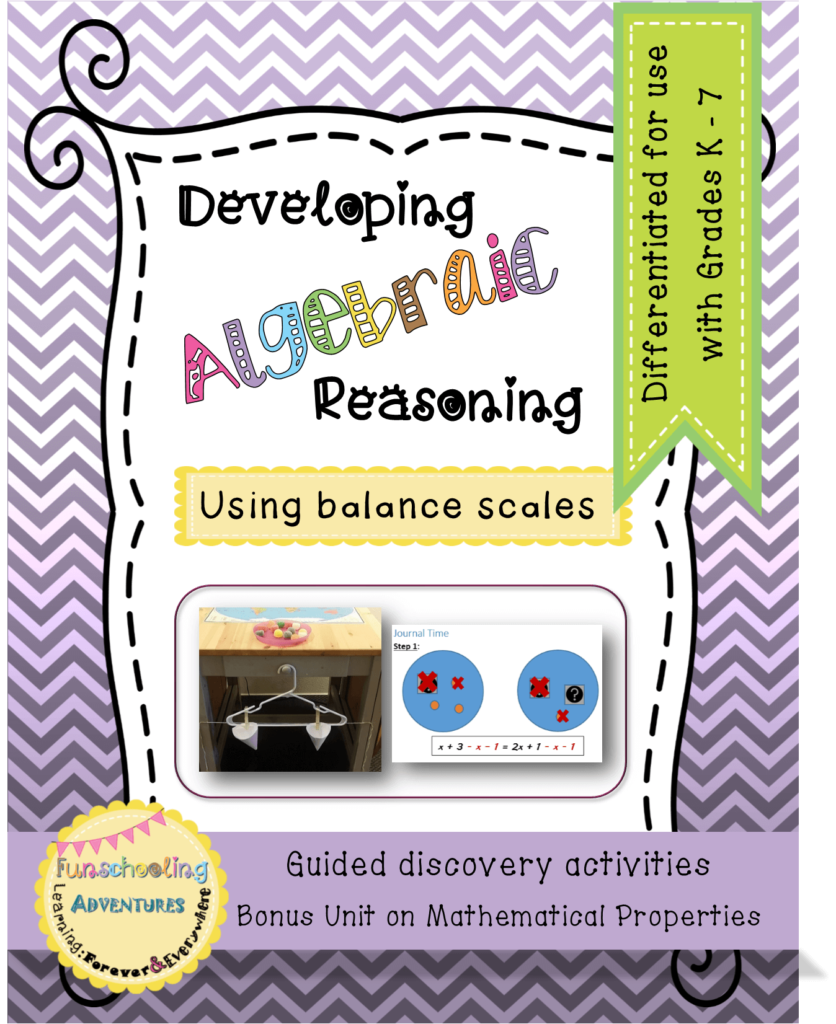
If you are a teacher, tutor, or homeschooling parent looking for an engaging way to introduce your students to the foundations of Algebraic thinking, I believe that you will find this resource very helpful. Based on my experience teaching high school Algebra and homeschooling my own children, I have created this activity based lesson pack to help you take your students through the amazing journey of thinking abstractly, reasoning mathematically, and communicating effectively while exploring hands-on activities (with candy!). I have scaffolded the lessons so that students of any age can complete and understand the lessons; younger students can explore ideas tangibly and intuitively while older students will see connections to other math concepts and will learn to confidently manipulate equations to solve for a single variable based on a strong visual and concrete understanding.
Introduction to the Mathematical Property of Equality
One of the core “pillar concepts” in math is Equality. In the early grades, the equals sign is used to represent the answer to a problem. Extending the idea further, however, the equals sign comes to mean that both sides of the equation are balanced; therefore, whatever mathematical operation is done to one side must be done to the other side. Although this may seem like a basic idea, I’ve noticed in my 6 years of teaching Algebra that many students work their way through years of math without truly understanding this concept. This lack of a solid foundation then becomes a handicap to them as they advance into Algebra and higher levels of math.
The activities laid out here can be started with beginning learners (as young as 5) but the extension activities can be used with students up through Algebra. The sooner that students are introduced to these concepts, the stronger their foundation will be in math, and the faster they can progress through the following modules, lessons, and extension activities.
Preview Pages
Here are 3 preview pages of the complete unit:
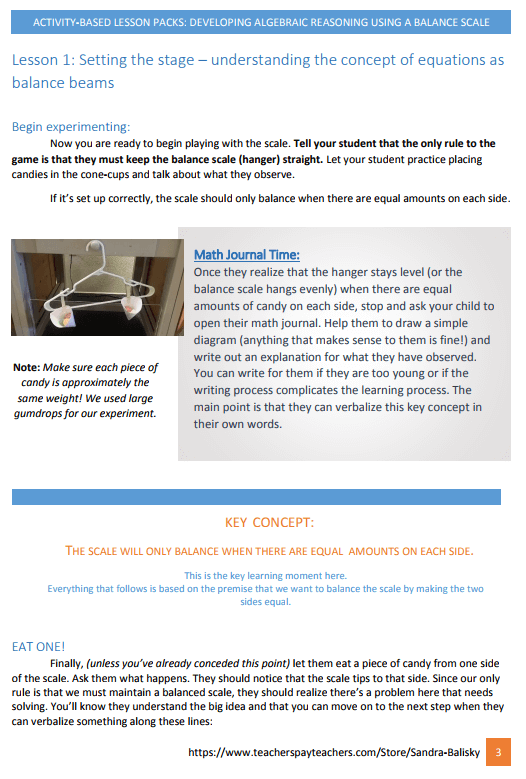
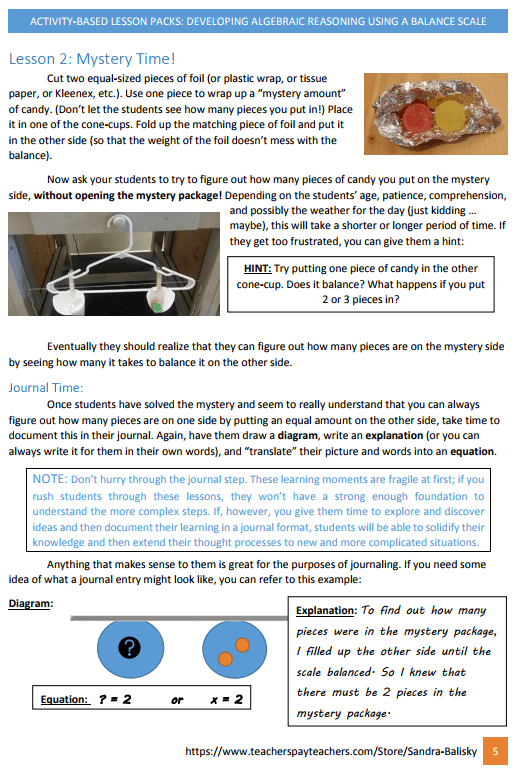

You can read more about our experience working through these activities in this article:
Thank you for taking the time to stop by! I hope that this material can help you enjoy doing math with your children and students. If there’s any type of product you’d like to see, please let me know and I’d be happy to try to create something tailored to your own family’s needs. I’d also absolutely love to hear any feedback on how these units work out for you and your kids, as well as any questions or suggestions.
Have a wonderful day!
Sandra

1 comment on “Cyber Monday sale — 60% off math resources”